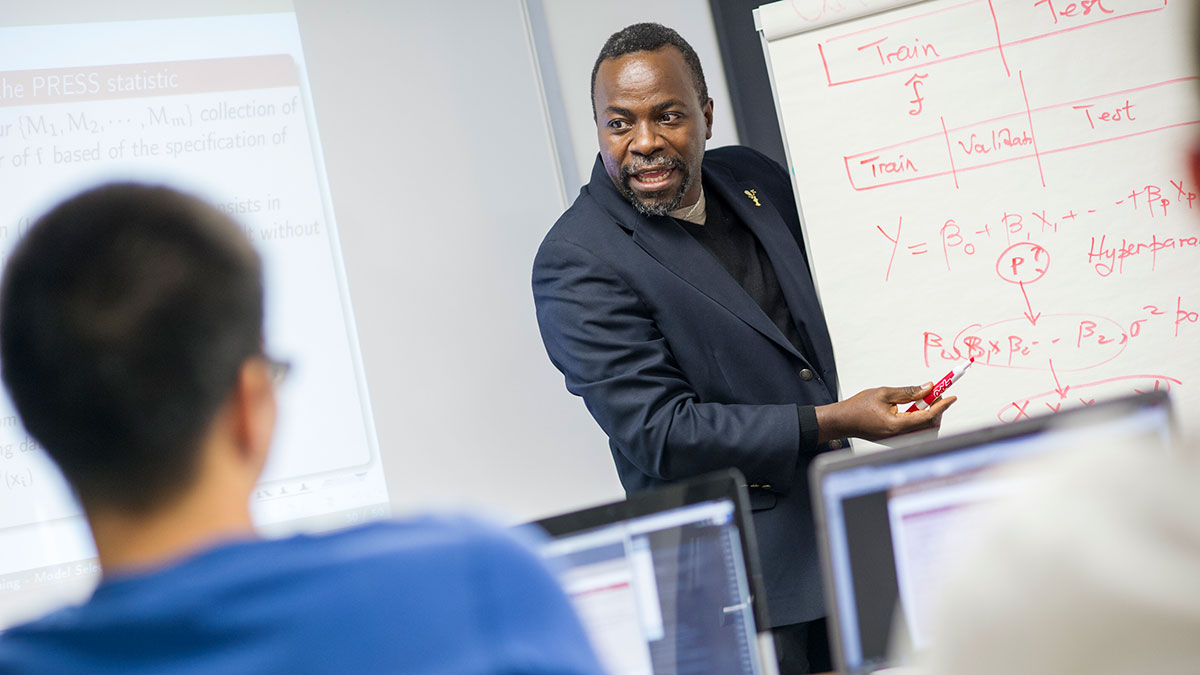Harnessing the Data Revolution

Harnessing the Data Revolution
- RIT/
- College of Science/
- Research/
- Harnessing the Data Revolution
RIT faculty and students conduct research on "Big Data" and the ability to discover patterns and make predictions from large amounts of data revolutionize almost every other scientific and technical field.
Applied Inverse Problems and Optimization
Current research in the unit involves developing mathematical frameworks to discern the properties of a system by working backward from known effects. Application areas include medicine, engineering, finance, earth science, and imaging and the focus is on investigating the impact of uncertainty in data, identification of cancer in soft tissues, estimation of material properties, identification of market volatility, and developing fast and reliable methods for large scale computational optimization.
Applied Statistics and Data Analytics
Current work in the unit includes research and consulting in biostatistics, machine learning, data science, predictive analytics, signals processing, statistical education, and statistical/scientific inference with applications to biology, astrophysics, and engineering.
Bioinformatics
Using modern computational tools and approaches the bioinformatics faculty conduct research on a broad variety of topics including molecular evolution, ecological modeling, cancer biology, and genomics.
Discrete Mathematics
Current work in the unit involves developing graph-based models of the brain to study the impact of concussions, improving and developing new graph-based algorithms for hyper-spectral image analysis, applying the growing concepts of complex network analysis to domain-based scientific problems, and applying algebraic techniques and methods to problems in cybersecurity.
Dynamical Systems and Fluid Dynamics
Current work in the unit involves applying mathematical techniques of nonlinear dynamical systems to problems in fluid dynamics, climate modeling, population modeling, cell signaling dynamics, and more; developing mathematical models of thin film and interfacial flows with application to biological fluids, micro-fluidics devices, and industrial coating processes; gaining insights that lead to better prediction of hydrodynamic instabilities, such as turbulence, liquid fuel atomization, and liquid film breakup; devising novel computational methods to simulate fluid transport phenomena; and improving the current understanding of polymer flows and viscoelastic fluids.
Geometry, Relativity, and Gravitation
Current work in the unit includes applications of differential geometry, numerical solutions of partial differential equations, and statistical inference to problems related to general relativity and celestial mechanics. Einstein's general theory of relativity is studied as a description of the geometry of spacetime. Advanced numerical and computational techniques are used to solve the coupled, nonlinear, system of PDEs of General Relativity and Magneto-Hydrodynamics. As part of the LIGO Scientific Collaboration, SMS faculty and researchers use statistical signal processing techniques to search for, identify and characterize gravitational-wave signals from astrophysical systems.
Mathematics of Earth and Environmental Systems
Current work in the unit involves developing new mathematical techniques to study problems of geophysical fluid dynamics, climate modeling, extreme weather, coastal and natural hazards, and other complex systems arising in the study of Earth and environmental systems.
Multi-messenger and Multi-wavelength Astrophysics
RIT faculty conduct observational and theoretical research across a wide range of topics in multi-messenger and multi-wavelength astrophysics, utilizing a combination of observations spanning the electromagnetic spectrum, data from gravitational wave detectors, and supercomputer simulations. Current areas of research include numerical relativity and relativistic magnetohydrodynamics, gravitational wave data analysis, compact object binaries, accretion disks and jets, supernovae, and pulsars. RIT is a member of the Large Synoptic Survey Telescope Corporation and faculty are involved in several major collaborations including the Laser Interferometer Gravitational Wave Observatory Scientific Collaboration, the NANOGrav Pulsar Timing Array Consortium and the Laser Interferometer Space Antenna.
The RIT Center for Computational Relativity and Gravitation advances knowledge and discovery at the frontiers of relativistic astrophysics, gravitational physics, and cosmology, while pursuing new exciting research directions, in connection with new experiments and observations.




































































